Results of FY2021 Survey on implementation status of Educational Travel to Japan
Japan National Tourism Organization (JNTO) surveyed organizations and associations nationwide accepting educational travel to Japan (e.g., prefectural tourism divisions and tourist associations) on the acceptance of educational travel to Japan in FY2021.
The responses obtained from total 48 organizations and associations, across all prefectures, were compiled, and a summary is provided on this page.
Continuing from the previous fiscal year, it remained difficult to accept in-person exchanges in 2021 due to the impact of COVID-19, and many schools in Japan are conducting “online exchanges” via the Internet. This survey focused on the implementation status of online exchanges, as well as initiatives and issues related to the resumption of in-person exchanges in the future.
Please note that the responses collected are based on the understanding of the staff member who completed the questionnaire, and may not accurately reflect the circumstances of each area.
1. 2021 Online School Exchanges
When a survey was conducted on the implementation status of online exchanges, the total of respondents who answered that they “conducted matching of online exchanges” for schools with/without a prior record of online school exchange was 50%. “Other” consisted of “Although the municipality was not involved, schools independently interacted with sister schools,” “Schools exchanged letters and video letters,” and “Schools held an online reunion with past participating students.” 34% of respondents answered “None.”
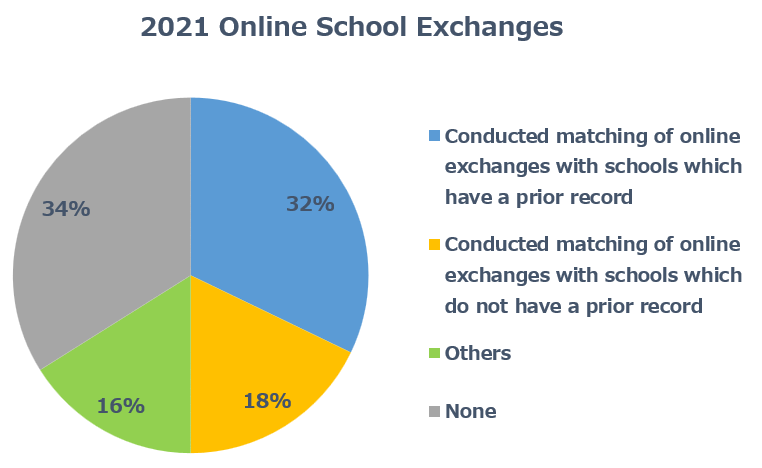
2. Percentage of number of online exchanges held by country/region
By market, 56% of online participating students were from Taiwan while 14% were from South Korea; accounting for 70% of the total when combined. “Other” included Malaysia, Jamaica, Mongolia, Thailand, etc. indicating that, compared to last year, online exchanges with various countries and regions are increasing.
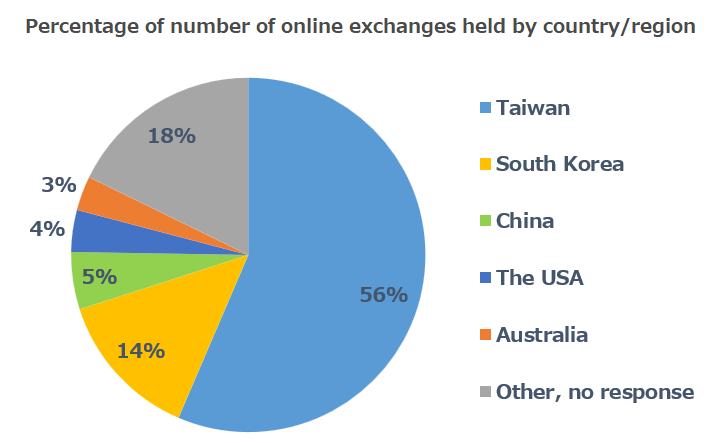
3. Percentage of number of schools which held online exchanges
Regarding the number of schools which held online exchanges, senior high schools accounted for the most, at 80%. Next was junior high schools at 9%, and elementary schools at 8%.
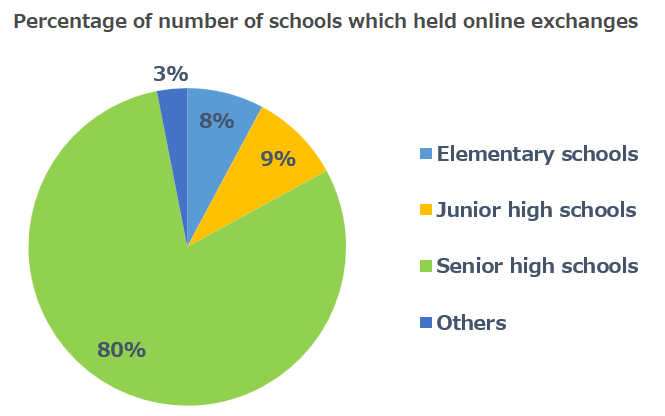
4. Tools used in online exchanges
Online exchanges were conducted by video conference tools. We examined which tools were used the most. Results showed that zoom was the most used tool at 50%, followed by Google Meet at 38%; accounting for close to 90% of the total when combined.

5. Average interaction time of online exchanges
The average time spent online exchanges was 60 minutes for 41% of respondents and 90 minutes for 31%; accounting for more than 70% of the total when combined. Also, the duration for the online exchanges for all schools was within 120 minutes.
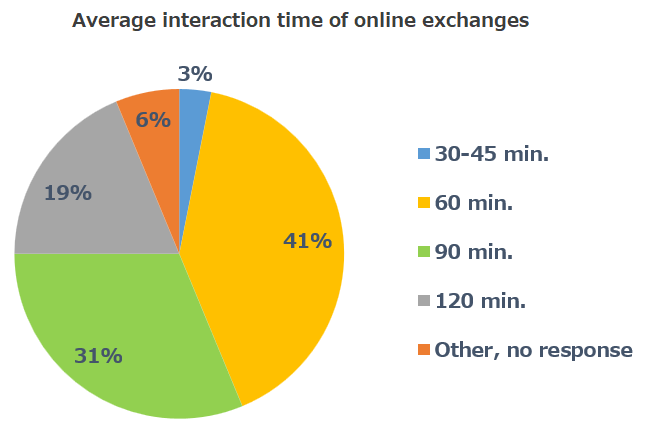
6. Online exchange contents
When we asked about the contents of online exchanges, we received the following responses:
Introduction of school and school life/homeland/culture, self-introduction
Deepened mutual understanding by introducing the schools and student life, homeland, culture, etc. of both sides, as well as individual student’s recent situations, hobbies, interests, etc.
Themed presentations, discussions
Held discussions and presentations on specific themes such as SDGs, environmental issues, and what they were learning.
Interaction through quizzes, games, etc.
Had fun interacting through quizzes, word games, gesture games (charades), etc.
Other
Responses included “Tasted sweets from each other’s regions and shared impressions,” “Co-created a website,” and “Played music and sang chorus.”
7. Role of Local Government Contact Person During Online Exchange (including preparation)
When we conducted a survey on the role of local government contact people in implementing online exchanges, the most frequent response was “Presence on exchange day,” followed by preparations such as “Communication/coordination leading up to exchange day,” and “Selection of exchange school.”

8. Preparation for Teachers and Students
The teachers and students who participated on the online exchange responded as follows for the main types of preparation required for the implementation of an online exchange.
Creation and preparation of exchange content (faculty members)
Formulated a program, decided on exchange content, and prepared the necessary materials. Also prepared equipment such as computers, tablets, and projectors, secured an online environment and ran communication tests.
Liaison and coordination regarding implementation (faculty members)
Held meetings with the teachers and staff of the partner school in advance regarding rehearsals, schedule adjustment on the exchange day, content and flow of the exchange, etc.
Preparation and rehearsal for presentations (students)
Created presentations for the exchange and rehearsed playing games, musical instruments and singing. Also practiced greetings in the native language of the partner school’s country, and learned about the culture and lifestyle of the country.
9. Implementation in FY2022
According to a survey on the status of acceptance of school exchanges in the 2022 academic year (as of May 2021), 38% of respondents said that “We are actively considering accepting in-person exchanges with overseas schools depending on the situation regarding the resumption of international visits.” 35% of respondents answered “If international travel restrictions ease, we will accept in-person exchanges with overseas schools,” and 13% answered “We already have schools that we are matched with and confirmed online exchanges for 2022,” indicating that the number of schools considering online exchanges is increasing compared to last year.
Other responses included, “We will continue online exchanges for the time being, and consider in-person school exchanges depending on the situation.”
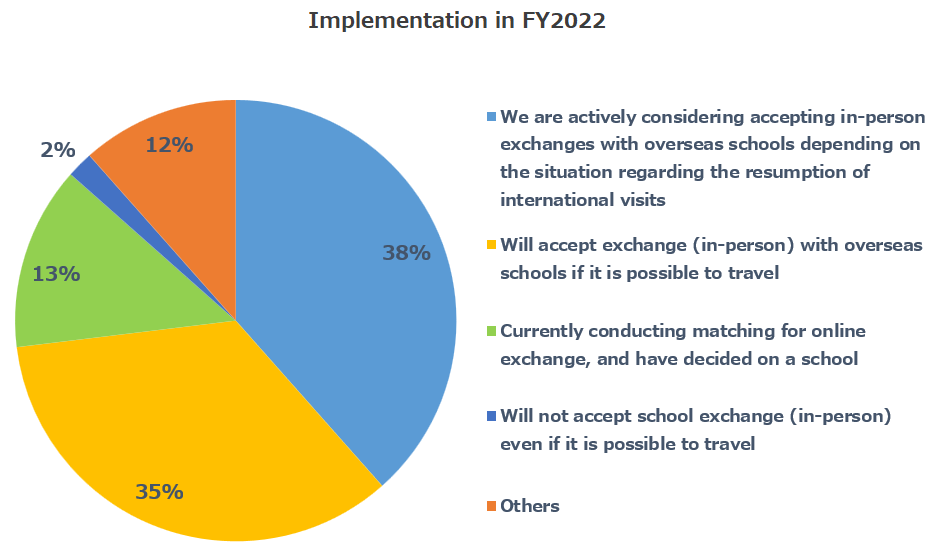
10. Information Required when Considering School exchange
We asked local Organizations, associations and schools what they needed in order to implement online exchanges and resume in-person exchanges. The main responses were as follows.
Information on partner school
The most common response was that local Organizations, associations and schools want information on any potential partner schools. Specifically, many respondents expressed multiple opinions such as they want to know what kind of exchange content the other party is looking for in terms of school culture and characteristics, types of students, student population, etc.
COVID-19 information
Since COVID-19 countermeasures and awareness differ depending on the country and region, many respondents said that they would like to know related information so that both sides can participate in exchanges safely and securely. There was also an opinion that it would be best to have guidelines established summarizing information such as the current infection status, countermeasures, timing of easing of travel restrictions, etc.
Exchange content and method
Especially with regard to online exchange, there are many contact people at both local Organizations, associations and schools who lack experience so they seek information regarding specific content of exchanges, such as what kind of programs are beneficial, the time spent on an exchange, and the grade/number of participating students.
Stories and exchange status of other schools
Quite a number of respondents expressed their desire know how the other schools are conducting exchanges and, if possible, they want to visit to observe what the other schools are doing in order to formulate the content of an exchange in concrete terms.
11. Future issues for school exchanges (including online exchange)
The following responses were particularly numerous regarding future issues for school interactions, including online exchanges:
Awareness-raising and follow-up for exchange hosting schools and students
Awareness-raising among schools and students who are less interested in international exchange, support for successful matching, reduction of the preparation burden on schools, etc.
COVID-19 situation and infectious disease protection measures upon resumption of in-person exchanges
There was concern expressed regarding how the Japanese government’s easing of border measures will proceed moving forward. There was also a focus on infection prevention measures and emergency response after in-person exchanges recommenced, and the formulation of guidelines related to such matters.
Enhancement and effective use of exchange content
Issues identified included the need to implement exchanges that fully ascertained the requests of both schools, the need to devise ways to make online exchanges ultimately lead to in-person exchanges, rather than once-off encounters, and others.
Japan National Tourism Organization (JNTO) surveyed organizations and associations nationwide accepting educational travel to Japan (e.g., prefectural tourism divisions and tourist associations) on the acceptance of educational travel to Japan in FY2021.
The responses obtained from total 48 organizations and associations, across all prefectures, were compiled, and a summary is provided on this page.
Continuing from the previous fiscal year, it remained difficult to accept in-person exchanges in 2021 due to the impact of COVID-19, and many schools in Japan are conducting “online exchanges” via the Internet. This survey focused on the implementation status of online exchanges, as well as initiatives and issues related to the resumption of in-person exchanges in the future.
Please note that the responses collected are based on the understanding of the staff member who completed the questionnaire, and may not accurately reflect the circumstances of each area.
1. 2021 Online School Exchanges
When a survey was conducted on the implementation status of online exchanges, the total of respondents who answered that they “conducted matching of online exchanges” for schools with/without a prior record of online school exchange was 50%. “Other” consisted of “Although the municipality was not involved, schools independently interacted with sister schools,” “Schools exchanged letters and video letters,” and “Schools held an online reunion with past participating students.” 34% of respondents answered “None.”

2. Percentage of number of online exchanges held by country/region
By market, 56% of online participating students were from Taiwan while 14% were from South Korea; accounting for 70% of the total when combined. “Other” included Malaysia, Jamaica, Mongolia, Thailand, etc. indicating that, compared to last year, online exchanges with various countries and regions are increasing.

3. Percentage of number of schools which held online exchanges
Regarding the number of schools which held online exchanges, senior high schools accounted for the most, at 80%. Next was junior high schools at 9%, and elementary schools at 8%.

4. Tools used in online exchanges
Online exchanges were conducted by video conference tools. We examined which tools were used the most. Results showed that zoom was the most used tool at 50%, followed by Google Meet at 38%; accounting for close to 90% of the total when combined.

5. Average interaction time of online exchanges
The average time spent online exchanges was 60 minutes for 41% of respondents and 90 minutes for 31%; accounting for more than 70% of the total when combined. Also, the duration for the online exchanges for all schools was within 120 minutes.

6. Online exchange contents
When we asked about the contents of online exchanges, we received the following responses:
Introduction of school and school life/homeland/culture, self-introduction
Deepened mutual understanding by introducing the schools and student life, homeland, culture, etc. of both sides, as well as individual student’s recent situations, hobbies, interests, etc.
Themed presentations, discussions
Held discussions and presentations on specific themes such as SDGs, environmental issues, and what they were learning.
Interaction through quizzes, games, etc.
Had fun interacting through quizzes, word games, gesture games (charades), etc.
Other
Responses included “Tasted sweets from each other’s regions and shared impressions,” “Co-created a website,” and “Played music and sang chorus.”
7. Role of Local Government Contact Person During Online Exchange (including preparation)
When we conducted a survey on the role of local government contact people in implementing online exchanges, the most frequent response was “Presence on exchange day,” followed by preparations such as “Communication/coordination leading up to exchange day,” and “Selection of exchange school.”

8. Preparation for Teachers and Students
The teachers and students who participated on the online exchange responded as follows for the main types of preparation required for the implementation of an online exchange.
Creation and preparation of exchange content (faculty members)
Formulated a program, decided on exchange content, and prepared the necessary materials. Also prepared equipment such as computers, tablets, and projectors, secured an online environment and ran communication tests.
Liaison and coordination regarding implementation (faculty members)
Held meetings with the teachers and staff of the partner school in advance regarding rehearsals, schedule adjustment on the exchange day, content and flow of the exchange, etc.
Preparation and rehearsal for presentations (students)
Created presentations for the exchange and rehearsed playing games, musical instruments and singing. Also practiced greetings in the native language of the partner school’s country, and learned about the culture and lifestyle of the country.
9. Implementation in FY2022
According to a survey on the status of acceptance of school exchanges in the 2022 academic year (as of May 2021), 38% of respondents said that “We are actively considering accepting in-person exchanges with overseas schools depending on the situation regarding the resumption of international visits.” 35% of respondents answered “If international travel restrictions ease, we will accept in-person exchanges with overseas schools,” and 13% answered “We already have schools that we are matched with and confirmed online exchanges for 2022,” indicating that the number of schools considering online exchanges is increasing compared to last year.
Other responses included, “We will continue online exchanges for the time being, and consider in-person school exchanges depending on the situation.”

10. Information Required when Considering School exchange
We asked local Organizations, associations and schools what they needed in order to implement online exchanges and resume in-person exchanges. The main responses were as follows.
Information on partner school
The most common response was that local Organizations, associations and schools want information on any potential partner schools. Specifically, many respondents expressed multiple opinions such as they want to know what kind of exchange content the other party is looking for in terms of school culture and characteristics, types of students, student population, etc.
COVID-19 information
Since COVID-19 countermeasures and awareness differ depending on the country and region, many respondents said that they would like to know related information so that both sides can participate in exchanges safely and securely. There was also an opinion that it would be best to have guidelines established summarizing information such as the current infection status, countermeasures, timing of easing of travel restrictions, etc.
Exchange content and method
Especially with regard to online exchange, there are many contact people at both local Organizations, associations and schools who lack experience so they seek information regarding specific content of exchanges, such as what kind of programs are beneficial, the time spent on an exchange, and the grade/number of participating students.
Stories and exchange status of other schools
Quite a number of respondents expressed their desire know how the other schools are conducting exchanges and, if possible, they want to visit to observe what the other schools are doing in order to formulate the content of an exchange in concrete terms.
11. Future issues for school exchanges (including online exchange)
The following responses were particularly numerous regarding future issues for school interactions, including online exchanges:
Awareness-raising and follow-up for exchange hosting schools and students
Awareness-raising among schools and students who are less interested in international exchange, support for successful matching, reduction of the preparation burden on schools, etc.
COVID-19 situation and infectious disease protection measures upon resumption of in-person exchanges
There was concern expressed regarding how the Japanese government’s easing of border measures will proceed moving forward. There was also a focus on infection prevention measures and emergency response after in-person exchanges recommenced, and the formulation of guidelines related to such matters.
Enhancement and effective use of exchange content
Issues identified included the need to implement exchanges that fully ascertained the requests of both schools, the need to devise ways to make online exchanges ultimately lead to in-person exchanges, rather than once-off encounters, and others.